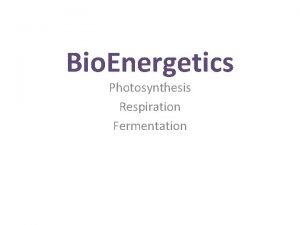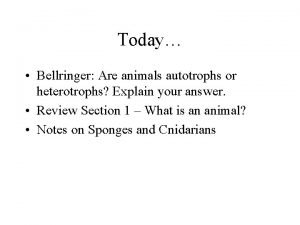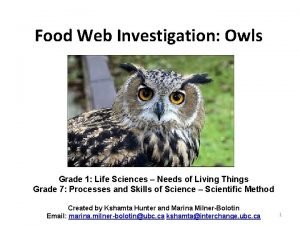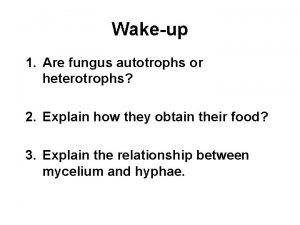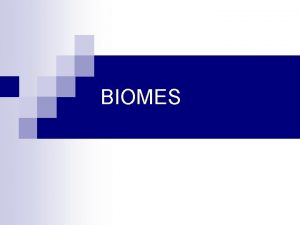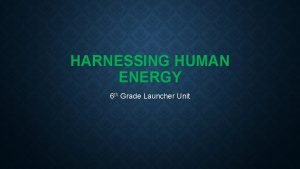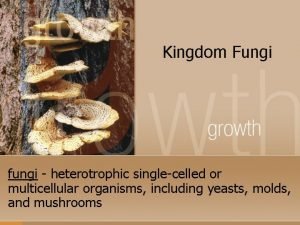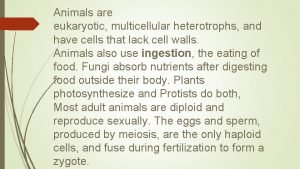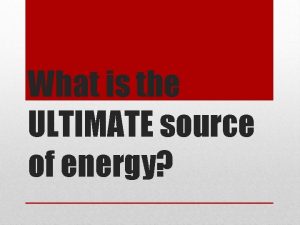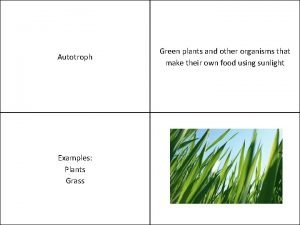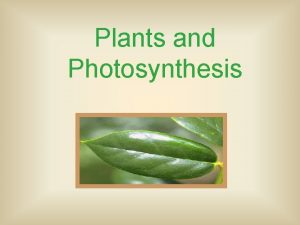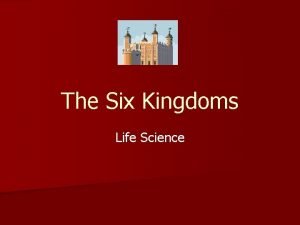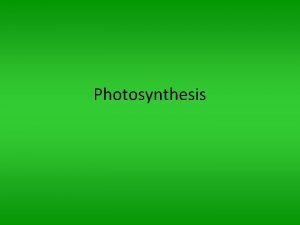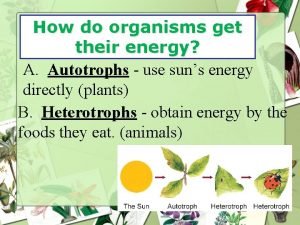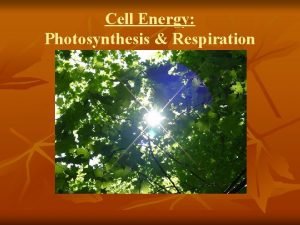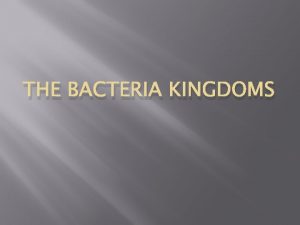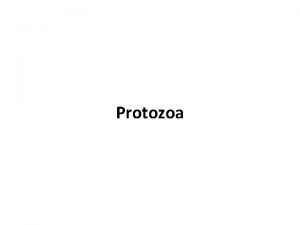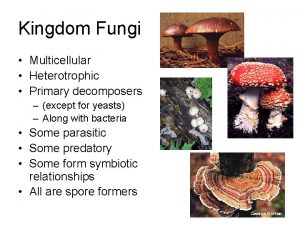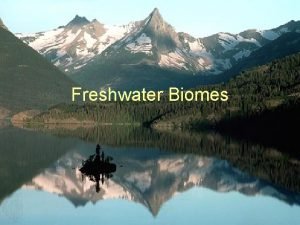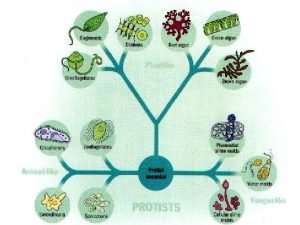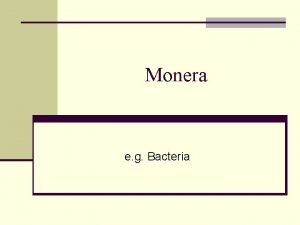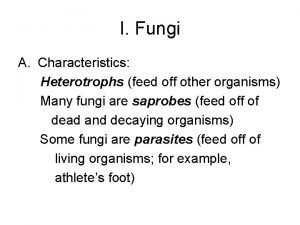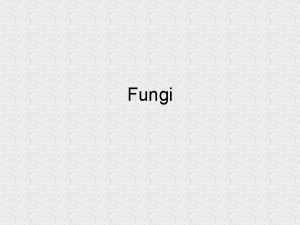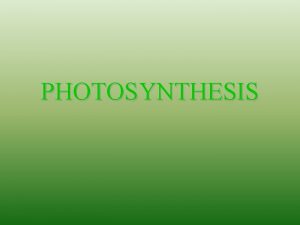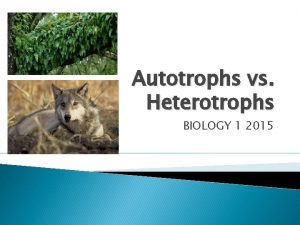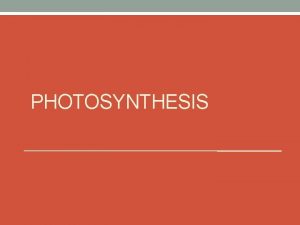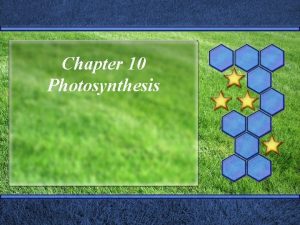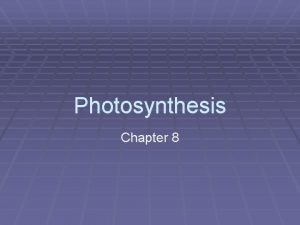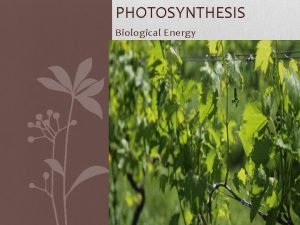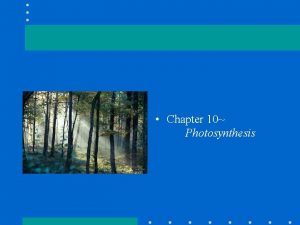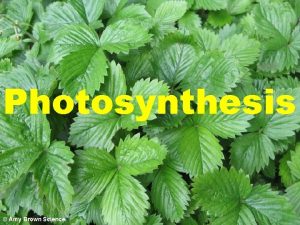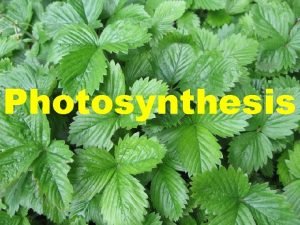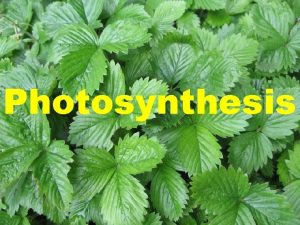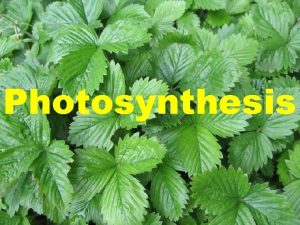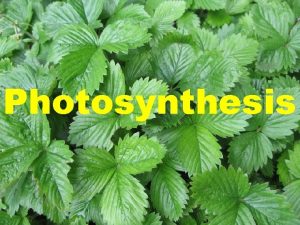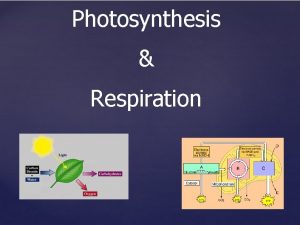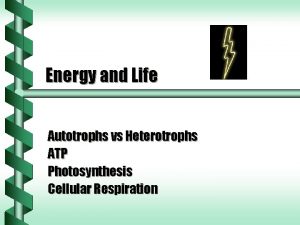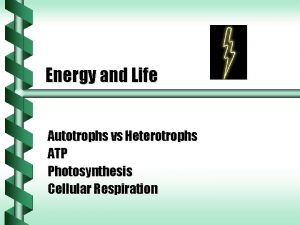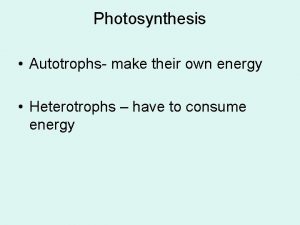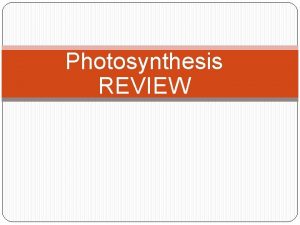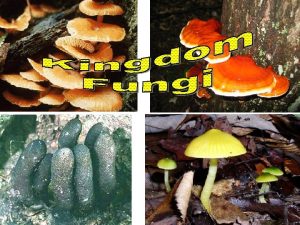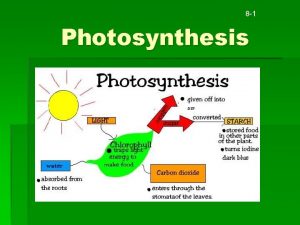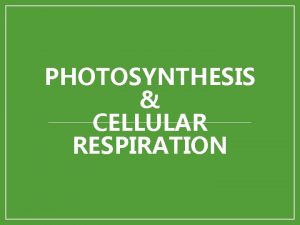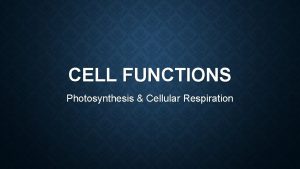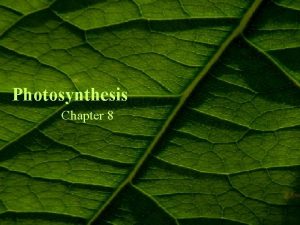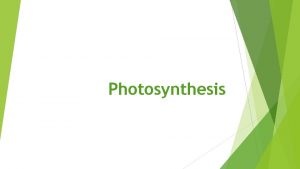PHOTOSYNTHESIS Harnessing Energy Heterotrophs and Autotrophs All living



































- Slides: 35

PHOTOSYNTHESIS Harnessing Energy

Heterotrophs and Autotrophs All living organisms require organic compounds and energy for their cells. Depending on how organisms obtain these compounds and energy, we classify them as being: heterotrophic (other feeding) or autotrophic (self-feeding).

Heterotrophs and Autotrophs Heterotrophic organisms such as animals, fungi and many bacteria must consume ‘food’ which provides organic compounds and energy for their cells. These heterotrophic organisms either ingest or absorb the organic matter of other living or dead organisms or their products. Autotrophic organisms such as plants, algae and several kinds of bacteria use do not ingest or absorb organic compounds. Autotrophic organisms use an external energy source to build organic compounds from simple inorganic compounds. Two different processes for trapping energy and creating organic matter from inorganic matter. These are chemosynthesis and photosynthesis.

Chemosynthesis F F Chemosynthetic organisms use the chemical energy within inorganic molecules. This energy comes from oxidising reactions. These reactions involve the addition of oxygen to (or the removal of electrons from) a substance. Examples include bacteria who obtain energy by converting: – Ammonium ions (NH 4+) to nitrite ions (NO 2 -) – Nitrite (NO 2 -) ions to nitrate (NO 3 -) – Sulfide ions (S 2 -) to sulfate ions (SO 42 -) F Whole communities of heterotrophic organisms live around volcanic vents on the deep ocean floors where light does not penetrate. They rely directly or indirectly on chemosynthetic bacteria for their food supply in much the same way as terrestrial communities depend on plants to trap energy.

Photosynthesis Organisms such as plants, algae and some protists (such as phytoplankton) are able to trap light energy and make organic compounds, such as sugars, from simple compounds such as carbon dioxide and water. Photosynthesis is the process in which light energy is transformed into chemical energy stored in sugars. Organisms with this ability are termed producers. Other organisms, such as animals and fungi, that depend, directly or indirectly, on the organic compounds produced by producers, are called consumers.

Photosynthesis F In a typical producer, such as a terrestrial flowering plant, the complex series of reactions in photosynthesis can be summarised as follows: carbon dioxide + water light chlorophyll --------------> light glucose + water+ oxygen 6 CO 2 + 12 H 2 O -------------chlorophyll > C 6 H 12 O + 6 H 2 O + 6 O 2

Where does photosynthesis occur? In a terrestrial flowering plant, only some cells are able to carry out photo synthesis and these are principally located in green leaves. The shape and structure of leaves equips them to carry out photosynthesis.

Why are leaves so special? Their flat shape provides a large surface area exposed to sunlight. The presence of many stomata (pores) on one or both leaf surfaces provides access into the leaf for carbon dioxide. The thinness and the presence of internal air spaces in the leaves enables the ready diffusion of carbon dioxide to photosynthetic cells in the leaf tissue. The network of xylem vessels in the vascular tissue transports water to the photosynthetic cells. Each photosynthetic cell possesses many chloroplasts enabling it to trap the energy of sunlight.

Chloroplasts Present in some cells of plants and algae. The boundary of each chloroplast is a double membrane (inner and outer). The inner membrane extends to form a system of membranous sacs called lamella or thylakoids. When several of these stack together they form grana. Chlorophyll is located in the grana. The semi-fluid substance between the grana is called the stroma.

Chlorophyll F F F Chlorophyll is pigment that absorbs or traps light. There are three types of chlorophyll – a, b and c. Chlorophyll a is the major photosynthetic pigment and is found in all photosynthetic plants, protists, and cyanobacteria. Chlorophyll molecules are embedded in the membrane structure of grana. Chlorophylls absorb wavelengths of violet-toblue and red light. They reflect green which is why leaves appear green.


Carotenoids are accessory pigments found in all green plants. They absorb blue and green wavelengths and give a plant a yellow or orange color. In the autumn when chlorophyll breaks down, it is the accessory pigments which are responsible for the colour. Accessory pigments are better at absorbing light at different wavelengths to chlorophyll a. They do not retain energy, but transfer it to chlorophyll a to enhance its effectiveness. NB: The red color of some autumn leaves is due to the anthocyanin pigments. These are not photosynthetic.

Stages of Photosynthesis from: “photo” – light “synthesis” – put together The name reflects the two-stage nature of the process. Light-dependent stage involving trapping of light energy Light-independent stage in which energy trapped in the first stage is used to make organic compounds from carbon dioxide and water.

LIGHT REACTIONS (Light dependent) Light absorption Electron transport Oxygen production Chemiosmotic ATP synthesis DARK REACTIONS (Light independent) Carbon Fixation

Light-dependent Reaction Also known as the light reaction. Occur within the grana of the chloroplasts Requires the input of water as well as light energy. Can be summarised by the reaction below:

Steps in light-dependent reaction Sunlight is trapped by chlorophyll a (or other pigments) and light energy is converted to chemical energy. Absorbed energy is used to produce ATP and split water molecules to form H+ ions and oxygen (waste product). This involves the electron transport chain. H+ ions are gathered by a carrier molecule or acceptor molecule (NADP in this case). NADP becomes NADPH and transports H+ ions from the grana to the stroma. H+ ions and ATP produced in light-dependent reaction are utilised in light-independent reaction.

Light dependent reaction

Light-independent Reaction Also known as dark reaction or Calvin cycle. Occurs in the stroma and involves the reduction of carbon. Does not directly depend on light involvement but does dependent on previous stage occurring. Can be summarised by the reaction below:

Steps in light-independent reaction Carbon reduction (from CO 2 to a sugar [C(H 2 O)]n) requires a supply of carbon dioxide and hydrogen ions, and an input of energy. Carbon dioxide can come from the air surrounding the leaf or from cellular respiration reactions. Energy required to drive these reactions comes from ATP and ‘loaded’ carriers (NADPH molecules) produced during the light-dependent stage. H+ is the reducing agent and ATP is the source of energy for reducing carbon dioxide to organic compounds such as glucose and other sugars. Plants do not build sugars simply by joining CO 2 molecules together. Sugar formation involves a cyclic set of reactions in which intermediate substances are formed.

Light independent reaction

C 3 plants F F F In most plants the first step in carbon reduction reaction is the Calvin cycle. The first step of this reaction is: Because the product of this reaction contains three carbon atoms, plants that carry out this reaction are known as C 3 plants.

The Calvin Cycle F Each time the cycle proceeds, one carbon dioxide molecule enters the cycle and is fixed and reduced. F To produce a 6 -carbon compound that is released from the cycle, six turns of the cycle must take place. F At the completion of each turn of the cycle, the starting compound is regenerated and so the cycle can proceed provided that CO 2, ATP and NADPH are also available. F The Calvin cycle in C 3 plants occurs in nearly all trees and most shrubs and herbs.

The Calvin Cycle

C 4 plants occur mainly in hot, dry habitats and include important crop plants such as corn and sugar cane. The light independent reaction of these plants involves a series of reactions which precede the Calvin cycle. In C 4 plants, the first step before the Calvin cycle is: The 4 -C compound undergoes further reactions and is transported to cells surrounding the vascular bundle. Once here, the 4 -C compound releases a molecule of carbon dioxide which enters the normal Calvin cycle.

Other variations on photosynthesis CAM (crassulacean acid metabolism) plants – Plants such as pineapples and cacti close their stomata during the day and open them at night, at which time they take up carbon dioxide and convert it to four-carbon organic acids (e. g. crassulacean acid), which accumulate in the central vacuole. – During the day, while the stomata are closed, carbon dioxide is released from these organic acids and used immediately for C 3 photosynthesis. – CAM plants are adapted to conditions of high daytime temperatures, intense sunlight and low soil moisture. Mistletoe – Although mistletoe plants, Amyema species, can carry out photosynthesis, they are partly parasitic because they must obtain their mineral nutrients and water from a host.

Which type of photosynthesis is best? C 3 plants Make stable molecules with 3 carbons C 4 plants CAM plants Use more ATP to produce stable 4 carbon sugar, so in cooler climates C 3 is more efficient Carbon dioxide released by the metabolism of cellular acids is used in C 3 photosynthesis Up to 50% of carbon dioxide absorbed through leaves is released before it can be used to make glucose by photosynthesis. In warm conditions the photosynthetic enzyme binds with oxygen instead of carbon dioxide Close their stomata during day and open them at night to prevent water loss in hot climates Have photosynthetic enzymes that never bind with oxygen and are more efficient during hot weather than C 3 plants

The importance of PGAL (phosphoglyceraldehyde) is an important 3 carbon compound formed during the Calvin cycle. PGAL is the starting point for the production of sugars in the cytosol outside the chloroplast: Two PGAL molecules can join to form fructose (6 carbon monosaccharide). Fructose can be converted to glucose. Fructose and glucose can combine to form sucrose – disaccharide form in which carbohydrates are transported from the leaf to other parts of the plant via the phloem Many glucose units can combine to form starch (storage molecule in plants).

The importance of sugars All cells can use sugars as a starting point for the manufacture of other carbohydrates and lipids. They can react sugars with nitrogen to form non-essential amino acids and nitrogenous bases that are found in nucleic acids. The chemical energy is starch is used directly or indirectly by consumers in cellular respiration to produce ATP for their energy requirements.

Factors that influence photosynthesis F Light intensity F Carbon dioxide availability F Temperature F Indirect factors

Light intensity The rate of photosynthesis usually increases with light intensity until there is another limiting factor, such as the saturation of chloroplasts. About 20% of light that hits the leaf is reflected. Only about 1% of light absorbed by the leaf is converted to chemical energy.

Carbon dioxide For most plants, carbon dioxide from air dissolves in extracellular fluid before entering photosynthetic cells. There are local variations in carbon dioxide levels in air, in different habitats and at different times of the day. Aquatic plants can also use hydrogen carbonate (carbonic acid), which forms when carbon dioxide dissolves in water. CO 2 released as a product of cellular respiration can also be used for photosynthesis, but usually only provides a small amount of the total carbon dioxide requirements. The degree to which the level of carbon dioxide affects the rate of photosynthesis is different for C 3, C 4 and CAM plants are more efficient than C 3 plants at trapping carbon dioxide when it is warm.

Compensation point At low levels of light intensity, the rate of photosynthesis is less than the rate of cellular respiration, so there is net output of carbon dioxide by plants. The light intensity at which the rate of carbon dioxide produced by cellular respiration equals the rate of carbon dioxide used in photosynthesis is known as the light compensation point.

Temperature Photosynthesis increases with increasing temperature until around 20 -40 o. C, depending on plant species, then it declines again. Plants that live in hotter climates are at higher end of the range. In C 3 plants, oxygen displaces trapped carbon dioxide more rapidly as temperature increases (enzyme binds oxygen instead of carbon dioxide).

Indirect factors Water Required in photosynthesis Only 1% of water passing up the xylem is used in photosynthesis. The rest is used in other chemical reactions, to hydrate cells or is lost in transpiration. If there is not enough water to hydrate the cells and keep them turgid, the stomata close. This prevents carbon dioxide entering the leaves, therefore photosynthesis decreases. Level of chlorophyll Limits photosynthesis Yellow leaves will have a lower rate of photosynthesis. Nitrogen and Magnesium Chlorophyll contains the elements nitrogen and magnesium. If the soil is deficient in one or both these elements, the plants cannot make sufficient chlorophyll.

Rate of photosynthesis Any of the factors that influence photosynthesis may limit the rate of photosynthesis. Photosynthesis will be limited by only one factor at a time, but if conditions in an individual chloroplast change, the particular factor that is limiting may also change. For example, carbon dioxide levels that are adequate (not limiting) in conditions of low light may become limiting if light intensity increases.
 Atp formula cellular respiration
Atp formula cellular respiration Explain how adp and atp are each like a battery
Explain how adp and atp are each like a battery Are cnidarians autotrophs
Are cnidarians autotrophs Food web for owls
Food web for owls Are fungi autotrophs or heterotrophs
Are fungi autotrophs or heterotrophs Answer sheet
Answer sheet Is eubacteria terrestrial or aquatic
Is eubacteria terrestrial or aquatic Harnessing human energy multiple choice questions
Harnessing human energy multiple choice questions What is the smallest living unit in all organisms?
What is the smallest living unit in all organisms? Fungi heterotrophic
Fungi heterotrophic All animals are multicellular heterotrophic eukaryotes
All animals are multicellular heterotrophic eukaryotes What is the ultimate source of energy for this food web?
What is the ultimate source of energy for this food web? Photosynthesis transforms light energy into chemical energy
Photosynthesis transforms light energy into chemical energy Venn diagram of living things and nonliving things
Venn diagram of living things and nonliving things Grass autotroph
Grass autotroph Granum
Granum What is this animal
What is this animal Are archaebacteria autotrophs
Are archaebacteria autotrophs Autotrophs
Autotrophs Which organism is an autotroph
Which organism is an autotroph Energy energy transfer and general energy analysis
Energy energy transfer and general energy analysis Energy energy transfer and general energy analysis
Energy energy transfer and general energy analysis Name
Name How do plants get glucose
How do plants get glucose Is moss living or non-living
Is moss living or non-living Living non living dead
Living non living dead Are archaebacteria heterotrophs
Are archaebacteria heterotrophs Unicellular heterotrophs
Unicellular heterotrophs Spider phylum
Spider phylum Where are lake biomes located
Where are lake biomes located Parasitic heterotrophs
Parasitic heterotrophs Unicellular heterotrophs
Unicellular heterotrophs Monera bacteria
Monera bacteria Fungi are eukaryotic heterotrophs
Fungi are eukaryotic heterotrophs Heterotrophs
Heterotrophs Define parasitic fungi
Define parasitic fungi
